Effects of Different Injection Strategies on Combustion and Emission Characteristics of Diesel Engine Fueled with Dual Fuel
Abstract
:1. Introduction
2. Numerical Methods
2.1. 1-D Numerical Calculation
2.1.1. Combustion Model
2.1.2. Heat Transfer Model
2.2. 3D-CFD Calculations
2.2.1. Fluid Flow and Combustion Model
2.2.2. Turbulence Model and Turbulence Diffusion Model
2.2.3. Spray, Collision, Evaporation, and Emission Models
2.2.4. Boundary Condition
- (1)
- Initial turbulent kinetic energy (TKE) of cylinder:where U0 is the turbulent fluctuation velocity, m/s.
- (2)
- Initial cylinder turbulence scale length:where Lv is the max. lift of the valve.
- (3)
- Fuel injection mass per cycle:where Vb is the fuel injection mass per cycle, g/cycle; be is the brake specific fuel consumption, g/(kw·h); pe is the power, kW; τn is the number of strokes; nf is the diesel engine speed, r/min; i is the number of cylinders.
3. Engine Setup and Experimental Cases
3.1. Engine Setup
3.2. Experimental Cases
3.3. Model Validation
4. Results and Discussion
4.1. Combustion Characteristics
4.2. Emission Characteristics
4.2.1. NOx Emission
4.2.2. Soot Emission
4.2.3. HC Emission
4.2.4. CO Emission
5. Conclusions
- (1)
- With the increase of NG mixing ratio, the max. cylinder pressure is reduced, but the cylinder temperature is increased. In addition, the NOx and CO emission are reduced. When the NG mixing ratio is 50%, the NOx and CO emission are reduced by 47% and 45%, respectively. However, the HC emission increases.
- (2)
- Compared with the single main injection, the pilot-main injection strategy can significantly improve the cylinder pressure and HRR. When the SODI1 is −30 °CA ATDC, the cylinder pressure increases by 19.6% and the cylinder temperature also increases by 4.6%. In terms of emission, the pilot-main injection can significantly reduce HC and CO in the cylinder. The soot emission firstly decreases and then increases, but NOx emission increases, when SODI1 is −38 °CA ATDC.
- (3)
- Compared with the single main injection, the main-post injection strategy can reduce the cylinder pressure and HRR. However, the cylinder temperature is reduced in the main injection stage. The NOx and CO emissions is reduced. When the SODI3 is 24 °CA ATDC, the NOx emission is reduced by 29.6%.
- (4)
- Compared with the single main injection, the pilot-main-post injection strategy slightly increase the cylinder pressure, HRR, and cylinder temperature. In terms of emission, it can effectively reduce the HC and CO emission. Due to the effects of pilot injection and post injection of diesel, the soot emission in cylinder increases, but the NOx emission in cylinder firstly decreases and then increases.
Author Contributions
Funding
Data Availability Statement
Conflicts of Interest
References
- Payri, F.; López, J.J.; Martín, J.; Carreño, R. Improvement and application of a methodology to perform the Global Energy Balance in internal combustion engines. Part 1: Global Energy Balance tool development and calibration. Energy 2018, 152, 666–681. [Google Scholar] [CrossRef]
- McClellan, R.O.; Hesterberg, T.W.; Wall, J.C. Evaluation of carcinogenic hazard of diesel engine exhaust needs to consider revolutionary changes in diesel technology. Regul. Toxicol. Pharmacol. 2012, 63, 225–258. [Google Scholar] [CrossRef] [Green Version]
- Cai, T.; Becker, S.; Wang, B.; Tang, A.; Fu, J.; Han, L.; Sun, Y.; Zhao, D. NO emission performance assessment on a perforated plate-implemented premixed ammonia-oxygen micro-combustion system. Chem. Eng. J. 2021, 417, 128033. [Google Scholar] [CrossRef]
- Zhang, Z.; Jiaqiang, E.; Chen, J.; Zhu, H.; Zhao, X.; Han, D.; Zuo, W.; Peng, Q.; Gong, J.; Yin, Z. Effects of low-level water addition on spray, combustion and emission characteristics of a medium speed diesel engine fueled with biodiesel fuel. Fuel 2019, 239, 245–262. [Google Scholar] [CrossRef]
- Cai, T.; Zhao, D.; Sun, Y.; Ni, S.; Li, W.; Guan, D.; Wang, B. Evaluation of NO emissions characteristics in a CO2-Free micro-power system by implementing a perforated plate. Renew. Sustain. Energy Rev. 2021, 145, 111150. [Google Scholar] [CrossRef]
- Zhang, Z.; Ye, J.; Tan, D.; Feng, Z.; Luo, J.; Tan, Y.; Huang, Y. The effects of Fe2O3 based DOC and SCR catalyst on the combustion and emission characteristics of a diesel engine fueled with biodiesel. Fuel 2021, 290, 120039. [Google Scholar] [CrossRef]
- Lešnik, L.; Kegl, B.; Torres-Jiménez, E.; Cruz-Peragón, F. Why we should invest further in the development of internal combustion engines for road applications. Oil Gas Sci. Technol. Rev. IFP Energ. Nouv. 2020, 75, 56. [Google Scholar] [CrossRef]
- Guo, C.; Zuo, Z.; Feng, H.; Roskilly, T. Advances in free-piston internal combustion engines: A comprehensive review. Appl. Therm. Eng. 2021, 189, 116679. [Google Scholar] [CrossRef]
- Jiaqiang, E.; Zhang, Z.; Chen, J.; Pham, M.; Zhao, X.; Peng, Q.; Zhang, B.; Yin, Z. Performance and emission evaluation of a marine diesel engine fueled by water biodiesel-diesel emulsion blends with a fuel additive of a cerium oxide nanoparticle. Energy Convers. Manag. 2018, 169, 194–205. [Google Scholar]
- Zhao, D.; Ji, C.; Li, X.; Li, S. Mitigation of premixed flame-sustained thermoacoustic oscillations using an electrical heater. Int. J. Heat Mass Transf. 2015, 86, 309–318. [Google Scholar] [CrossRef]
- Peng, Q.; Yang, W.M.; Jiaqiang, E.; Li, Z.; Xu, H.; Fu, G.; Li, S. Investigation on H2/air combustion with C3H8 addition in the combustor with part/full porous medium. Energy Convers. Manag. 2021, 228, 113652. [Google Scholar] [CrossRef]
- Zhao, D.; Gutmark, E.; Goey, P. A review of cavity-based trapped vortex, ultra-compact, high-g, inter-turbine combustors. Prog. Energy Combust. Sci. 2018, 66, 42–82. [Google Scholar] [CrossRef] [Green Version]
- Zhang, Z.; Jiaqiang, E.; Deng, Y.; Pham, M.; Zuo, W.; Peng, Q.; Yin, Z. Effects of fatty acid methyl esters proportion on combustion and emission characteristics of a biodiesel fueled marine diesel engine. Energy Convers. Manag. 2018, 159, 244–253. [Google Scholar] [CrossRef]
- Cai, T.; Zhao, D. Effects of fuel composition and wall thermal conductivity on thermal and NOx emission performances of an ammonia/hydrogen-oxygen micro-power system. Fuel Process. Technol. 2020, 209, 106527. [Google Scholar] [CrossRef]
- Pischinger, S. Current and Future Challenges for Automotive Catalysis: Engine Technology Trends and Their Impact. Top. Catal. 2016, 59, 834–844. [Google Scholar] [CrossRef]
- Zhang, J.-H.; Chen, M. Assessing the impact of China’s vehicle emission standards on diesel engine remanufacturing. J. Clean. Prod. 2015, 107, 177–184. [Google Scholar] [CrossRef]
- Czech, R.; Zabochnicka-Świątek, M.; Świątek, M.K. Air pollution as a result of the development of motorization. Glob. Nest J. 2020, 22, 220–230. [Google Scholar]
- Teixeira, A.C.R.; Machado, P.G.; Collaço, F.M.D.A.; Mouette, D. Alternative fuel technologies emissions for road heavy-duty trucks: A review. Environ. Sci. Pollut. Res. 2021, 28, 20954–20969. [Google Scholar] [CrossRef] [PubMed]
- Jiaqiang, E.; Zhao, X.; Qiu, L.; Wei, K.; Zhang, Z.; Deng, Y.; Han, D.; Liu, G. Experimental investigation on performance and economy characteristics of a diesel engine with variable nozzle turbocharger and its application in urban bus. Energy Convers. Manag. 2019, 193, 149–161. [Google Scholar]
- Peng, Q.; Yang, W.M.; Jiaqiang, E.; Li, S.; Li, Z.; Xu, H.; Fu, G. Effects of propane addition and burner scale on the combustion characteristics and working performance. Appl. Energy 2021, 285, 116484. [Google Scholar] [CrossRef]
- Zhao, J.; Zhang, Y.; Chang, J.; Peng, S.; Hong, N.; Hu, J.; Lv, J.; Wang, T.; Mao, H. Emission characteristics and temporal variation of PAHs and their derivatives from an ocean-going cargo vessel. Chemosphere 2020, 249, 126194. [Google Scholar] [CrossRef] [PubMed]
- Jiaqiang, E.; Liu, G.; Zhang, Z.; Han, D.; Chen, J.; Wei, K.; Gong, J.; Yin, Z. Effect analysis on cold starting performance enhancement of a diesel engine fueled with biodiesel fuel based on an improved thermodynamic model. Appl. Energy 2019, 243, 321–335. [Google Scholar]
- Lee, J.; Park, C.; Bae, J.; Kim, Y.; Lee, S.; Kim, C. Comparison between gasoline direct injection and compressed natural gas port fuel injection under maximum load condition. Energy 2020, 197, 117173. [Google Scholar] [CrossRef]
- Yang, Z.; Tate, J.E.; Morganti, E.; Shepherd, S.P. Real-world CO2 and NOX emissions from refrigerated vans. Sci. Total Environ. 2021, 763, 142974. [Google Scholar] [CrossRef] [PubMed]
- Kim, W.; Park, C.; Bae, C. Characterization of combustion process and emissions in a natural gas/diesel dual-fuel compression-ignition engine. Fuel 2021, 291, 120043. [Google Scholar] [CrossRef]
- Lee, S.; Kim, C.; Lee, S.; Oh, S.; Kim, J.; Lee, J. Characteristics of non-methane hydrocarbons and methane emissions in exhaust gases under natural-gas/diesel dual-fuel combustion. Fuel 2021, 290, 120009. [Google Scholar] [CrossRef]
- Millo, F.; Accurso, F.; Piano, A.; Caputo, G.; Cafari, A.; Hyvönen, J. Experimental and numerical investigation of the ignition process in a large bore dual fuel engine. Fuel 2021, 290, 120073. [Google Scholar] [CrossRef]
- Muhssen, H.S.; Masuri, S.U.; Sahari, B.B.; Hairuddin, A.A. Design improvement of compressed natural gas (CNG)-Air mixer for diesel dual-fuel engines using computational fluid dynamics. Energy 2021, 216, 118957. [Google Scholar] [CrossRef]
- Shen, Z.; Wang, X.; Zhao, H.; Lin, B.; Shen, Y.; Yang, J. Numerical investigation of natural gas-diesel dual-fuel engine with different piston geometries and radial clearances. Energy 2021, 220, 119706. [Google Scholar] [CrossRef]
- Yang, B.; Ning, L.; Liu, B.; Huang, G.; Cui, Y.; Zeng, K. Comparison study the particulate matter characteristics in a diesel/natural gas dual-fuel engine under different natural gas-air mixing operation conditions. Fuel 2021, 288, 119721. [Google Scholar] [CrossRef]
- Chen, Z.; Chen, H.; Wang, L.; Geng, L.; Zeng, K. Parametric study on effects of excess air/fuel ratio, spark timing, and methanol injection timing on combustion characteristics and performance of natural gas/methanol dual-fuel engine at low loads. Energy Convers. Manag. 2020, 210, 112742. [Google Scholar] [CrossRef]
- Yousefi, A.; Guo, H.; Birouk, M.; Liko, B.; Lafrance, S. Effect of post-injection strategy on greenhouse gas emissions of natural gas/diesel dual-fuel engine at high load conditions. Fuel 2021, 290, 120071. [Google Scholar] [CrossRef]
- Yousefi, A.; Guo, H.; Birouk, M. Split diesel injection effect on knocking of natural gas/diesel dual-fuel engine at high load conditions. Appl. Energy 2020, 279, 115828. [Google Scholar] [CrossRef]
- Yousefi, A.; Guo, H.; Birouk, M. Effect of diesel injection timing on the combustion of natural gas/diesel dual-fuel engine at low-high load and low-high speed conditions. Fuel 2019, 235, 838–846. [Google Scholar] [CrossRef]
- Huang, H.; Zhu, Z.; Chen, Y.; Chen, Y.; Lv, D.; Zhu, J.; Ouyang, T. Experimental and numerical study of multiple injection effects on combustion and emission characteristics of natural gas–diesel dual-fuel engine. Energy Convers. Manag. 2019, 183, 84–96. [Google Scholar] [CrossRef]
- Wang, H.; Gan, H.; Wang, G.; Zhong, G. Emission and Performance Optimization of Marine Four-Stroke Dual-Fuel Engine Based on Response Surface Methodology. Math. Probl. Eng. 2020, 2020, 5268314. [Google Scholar] [CrossRef]
- Lešnik, L.; Vajda, B.; Žunič, Z.; Škerget, L.; Kegl, B. The influence of biodiesel fuel on injection characteristics, diesel engine performance, and emission formation. Appl. Energy 2013, 111, 558–570. [Google Scholar] [CrossRef]
- Zhang, Z.; Jiaqiang, E.; Chen, J.; Zhao, X.; Zhang, B.; Deng, Y.; Peng, Q.; Yin, Z. Effects of boiling heat transfer on the performance enhancement of a medium speed diesel engine fueled with diesel and rapeseed methyl ester. Appl. Therm. Eng. 2020, 169, 114984. [Google Scholar] [CrossRef]
- Azimov, U.B.; Kim, K.S.; Jeong, D.S.; Lee, Y.G. Evaluation of low-temperature diesel combustion regimes with n-Heptane fuel in a constant-volume chamber. Int. J. Automot. Technol. 2009, 10, 265–276. [Google Scholar] [CrossRef]
- Šarić, S.; Basara, B.; Žunič, Z. Advanced near-wall modeling for engine heat transfer. Int. J. Heat Fluid Flow 2017, 63, 205–211. [Google Scholar] [CrossRef]
- Li, Y.; Huang, Y.; Luo, K.; Liang, M.; Lei, B. Development and validation of an improved atomization model for GDI spray simulations: Coupling effects of nozzle-generated turbulence and aerodynamic force. Fuel 2021, 299, 120871. [Google Scholar] [CrossRef]
- Kim, T.; Kim, D.; Park, S. Numerical approach to analyze propane flash boiling spray using modified gas-jet model. Appl. Therm. Eng. 2019, 162, 114255. [Google Scholar] [CrossRef]
- Perego, M.; Gunzburger, M.; Burkardt, J. Parallel finite-element implementation for higher-order ice-sheet models. J. Glaciol. 2017, 58, 76–88. [Google Scholar] [CrossRef] [Green Version]
- Rao, V.; Honnery, D. A comparison of two NOx prediction schemes for use in diesel engine thermodynamic modelling. Fuel 2013, 107, 662–670. [Google Scholar] [CrossRef]
- Li, W.; Ji, J.; Huang, L.; Guo, Z. Global dynamics of a controlled discontinuous diffusive SIR epidemic system. Appl. Math. Lett. 2021, 121, 107420. [Google Scholar] [CrossRef]
- Tan, D.; Chen, Z.; Li, J.; Luo, J.; Yang, D.; Cui, S.; Zhang, Z. Effects of Swirl and Boiling Heat Transfer on the Performance Enhancement and Emission Reduction for a Medium Diesel Engine Fueled with Biodiesel. Processes 2021, 9, 568. [Google Scholar] [CrossRef]
- Xue, R.; Zheng, X.; Yue, L.; Zhang, Q.; He, X.; Yang, J.; Weng, C.; Li, Z. Reduction of surface friction drag in scramjet engine by boundary layer combustion. Aerosp. Sci. Technol. 2021, 115, 106788. [Google Scholar] [CrossRef]
- Zuo, H.; Tan, J.; Wei, K.; Huang, Z.; Zhong, D.; Xie, F. Effects of different poses and wind speeds on wind-induced vibration characteristics of a dish solar concentrator system. Renew. Energy 2021, 168, 1308–1326. [Google Scholar] [CrossRef]
- Zuo, H.; Liu, G.; Jiaqiang, E.; Zuo, W.; Wei, K.; Hu, W.; Tan, J.; Zhong, D. Catastrophic analysis on the stability of a large dish solar thermal power generation system with wind-induced vibration. Sol. Energy 2019, 183, 40–49. [Google Scholar] [CrossRef]
- Hu, L.; Hu, X.; Che, Y.; Feng, F.; Lin, X.; Zhang, Z. Reliable state of charge estimation of battery packs using fuzzy adaptive federated filtering. Appl. Energy 2020, 262, 114569. [Google Scholar] [CrossRef]
- Zhang, F.; Liao, G.; Jiaqiang, E.; Chen, J.; Leng, E. Comparative study on the thermodynamic and economic performance of novel absorption power cycles driven by the waste heat from a supercritical CO2 cycle. Energy Convers. Manag. 2021, 228, 113671. [Google Scholar] [CrossRef]
- Cai, T.; Zhao, D.; Li, X.; Shi, B.; Li, J. Mitigating NOx Emissions from an Ammonia-fueled Micro-power System with a Perforated Plate Implemented. J. Hazard. Mater. 2021, 401, 123848. [Google Scholar] [CrossRef] [PubMed]
- Wu, G.; Wu, D.; Li, Y.; Meng, L. Effect of Acetone-n-Butanol-Ethanol (ABE) as an Oxygenate on Combustion, Performance, and Emission Characteristics of a Spark Ignition Engine. J. Chem. 2020, 2020, 1–11. [Google Scholar] [CrossRef] [Green Version]
- Jiaqiang, E.; Zhao, M.; Zuo, Q.; Zhang, B.; Zhang, Z.; Peng, Q.; Han, D.; Zhao, X.; Deng, Y. Effects analysis on diesel soot continuous regeneration performance of a rotary microwave-assisted regeneration diesel particulate filter. Fuel 2020, 260, 116353. [Google Scholar]
- Zhang, B.; Zuo, H.; Huang, Z.; Tan, J.; Zuo, Q. Endpoint forecast of different diesel-biodiesel soot filtration process in diesel particulate filters considering ash deposition. Fuel 2020, 272, 117678. [Google Scholar] [CrossRef]
- Wu, G.; Wang, X.; Abubakar, S.; Li, Y.; Liu, Z. A realistic skeletal mechanism for the oxidation of biodiesel surrogate composed of long carbon chain and polyunsaturated compounds. Fuel 2021, 289, 119934. [Google Scholar] [CrossRef]
- Xie, Y.; Zuo, Q.; Wang, M.; Wei, K.; Zhang, B.; Chen, W.; Tang, Y.; Wang, Z.; Zhu, G. Effects analysis on soot combustion performance enhancement of an improved catalytic gasoline particulate filter regeneration system with electric heating. Fuel 2021, 290, 119975. [Google Scholar] [CrossRef]
- Xie, Y.; Zuo, Q.; Zhu, G.; Guan, Q.; Wei, K.; Zhang, B.; Tang, Y.; Shen, Z. Investigations on the soot combustion performance enhancement of an improved catalytic gasoline particulate filter regeneration system under different electric heating powers. Fuel 2021, 283, 119301. [Google Scholar] [CrossRef]
- Cai, T.; Zhao, D.; Wang, B.; Li, J.; Guan, Y. NOx emission and thermal performances studies on premixed ammonia-oxygen combustion in a CO2-free micro-planar combustor. Fuel 2020, 280, 118554. [Google Scholar] [CrossRef]
- Zuo, Q.; Xie, Y.; Jiaqiang, E.; Zhu, X.; Zhang, B.; Tang, Y.; Zhu, G.; Wang, Z.; Zhang, J. Effect of different exhaust parameters on NO conversion efficiency enhancement of a dual-carrier catalytic converter in the gasoline engine. Energy 2020, 191, 116521. [Google Scholar] [CrossRef]
- Hu, L.; Bao, X.; Lin, M.; Yu, C.; Wang, F. Research on risky driving behavior evaluation model based on CIDAS real data. Proc. Inst. Mech. Eng. Part D J. Automob. Eng. 2021, 235, 2176–2187. [Google Scholar] [CrossRef]
- Hu, L.; Hu, X.; Kuang, A.; Lin, M.; Wang, J. Casualty risk of e-bike rider struck by passenger vehicle using China in- depth accident data. Traffic Injury Prev. 2020, 21, 283–287. [Google Scholar] [CrossRef] [PubMed]

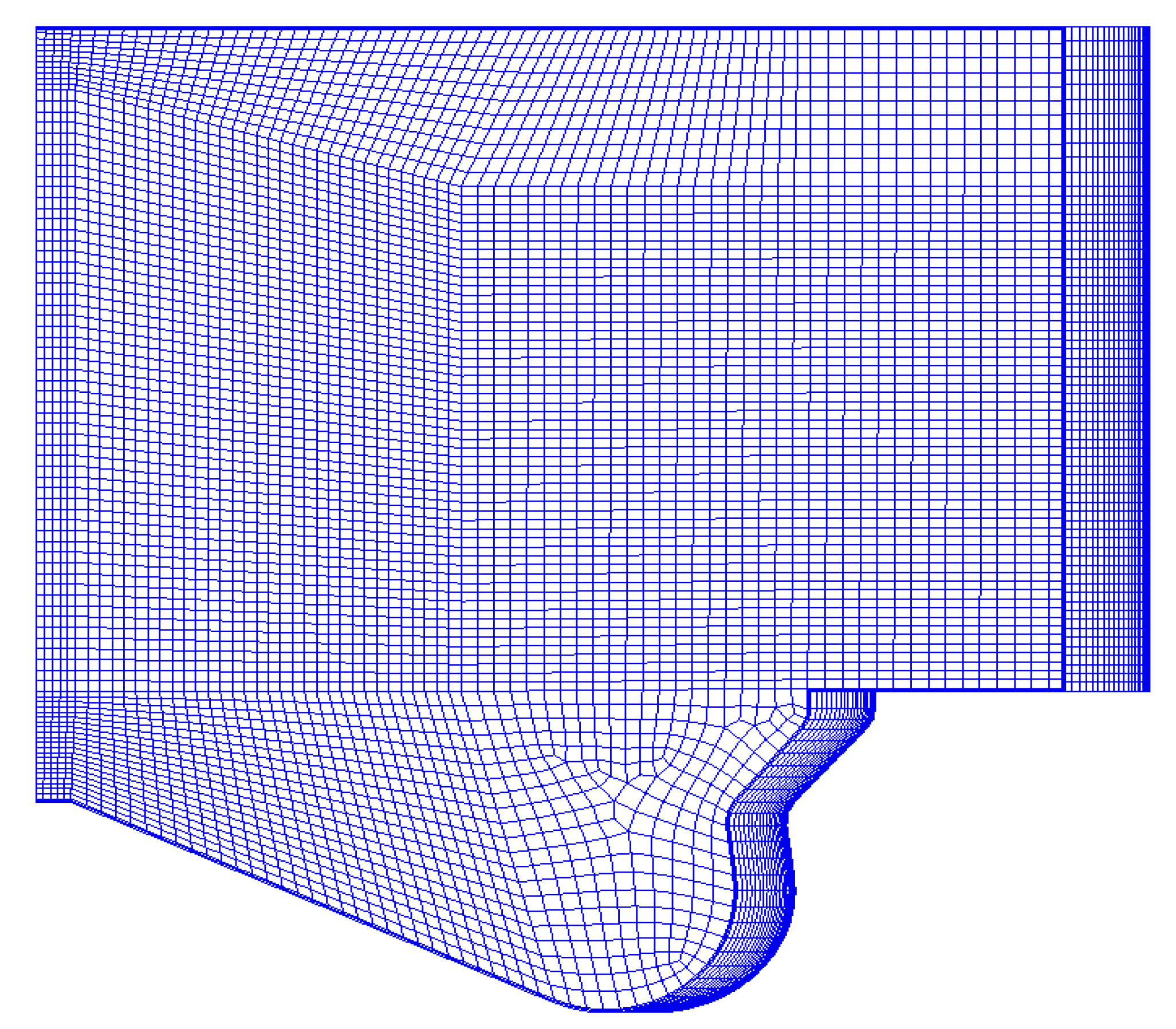
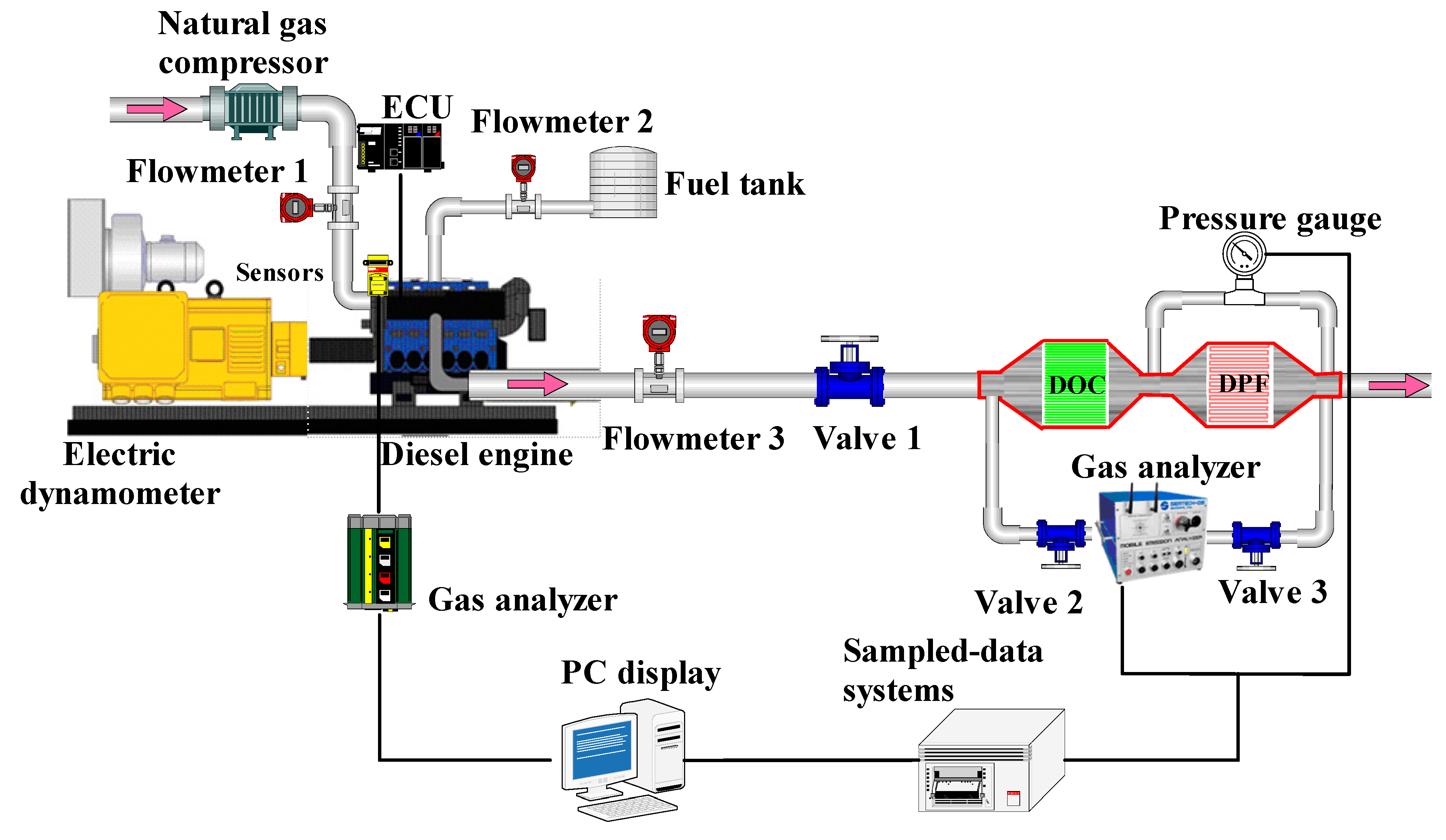
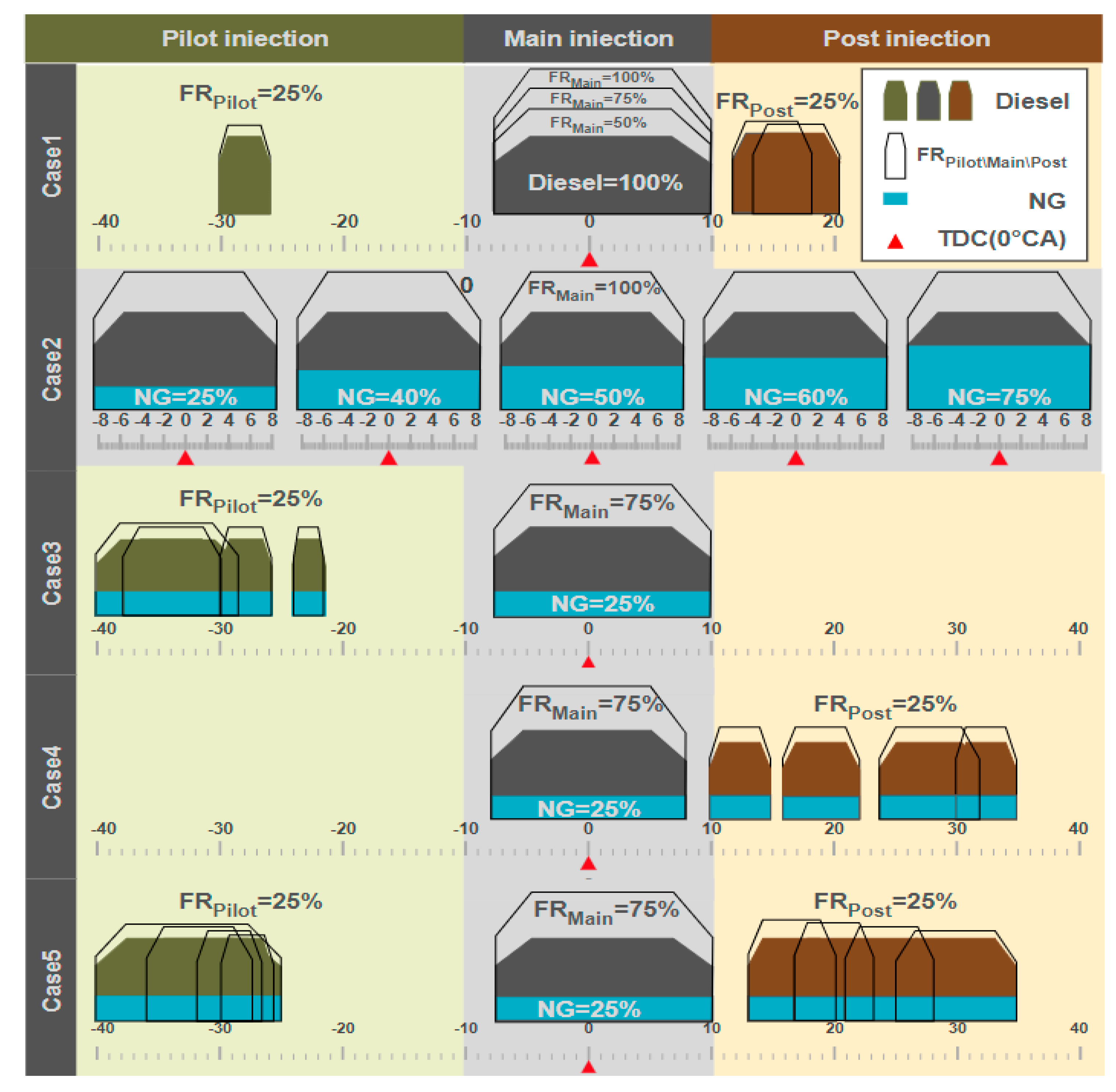
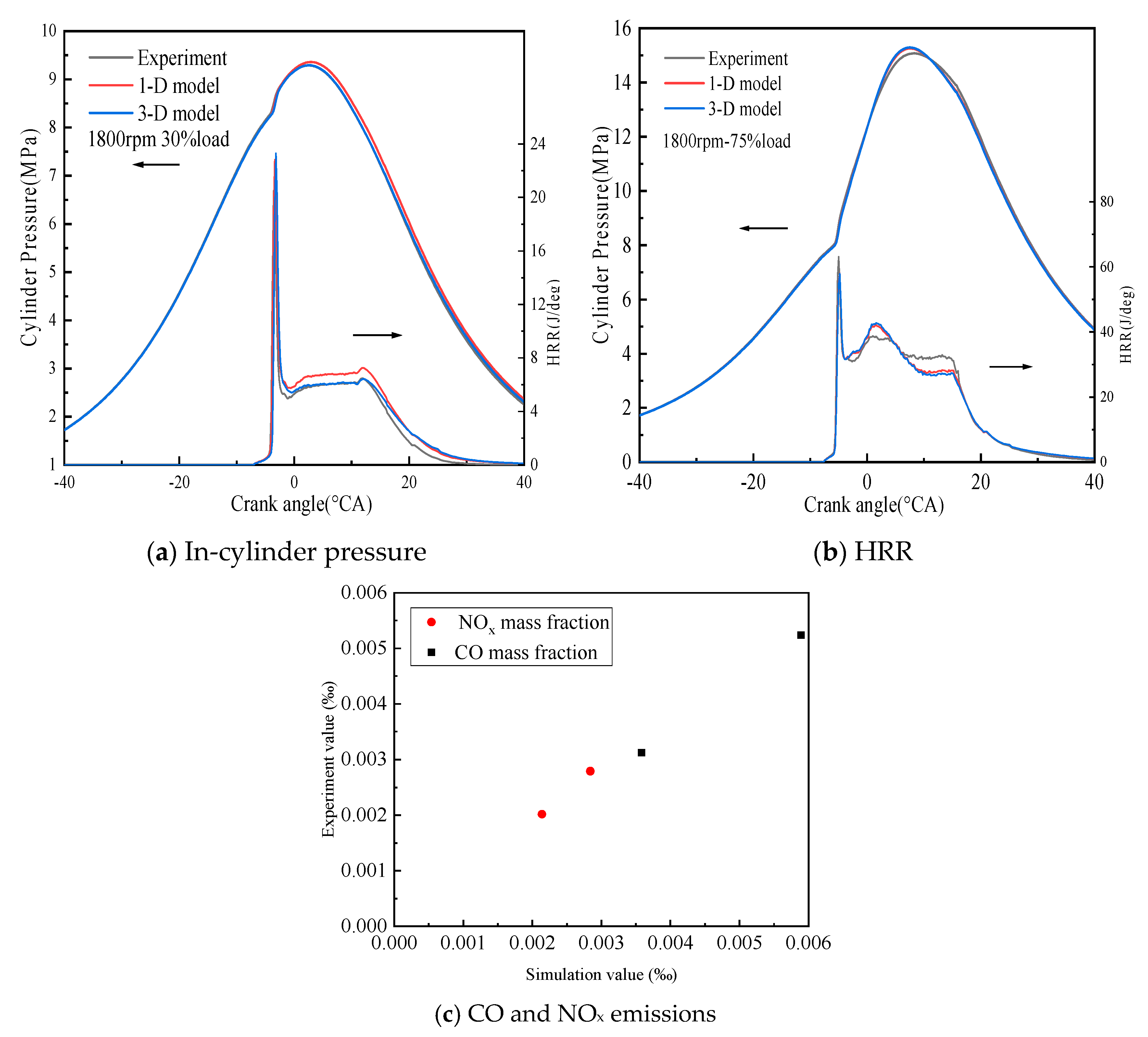
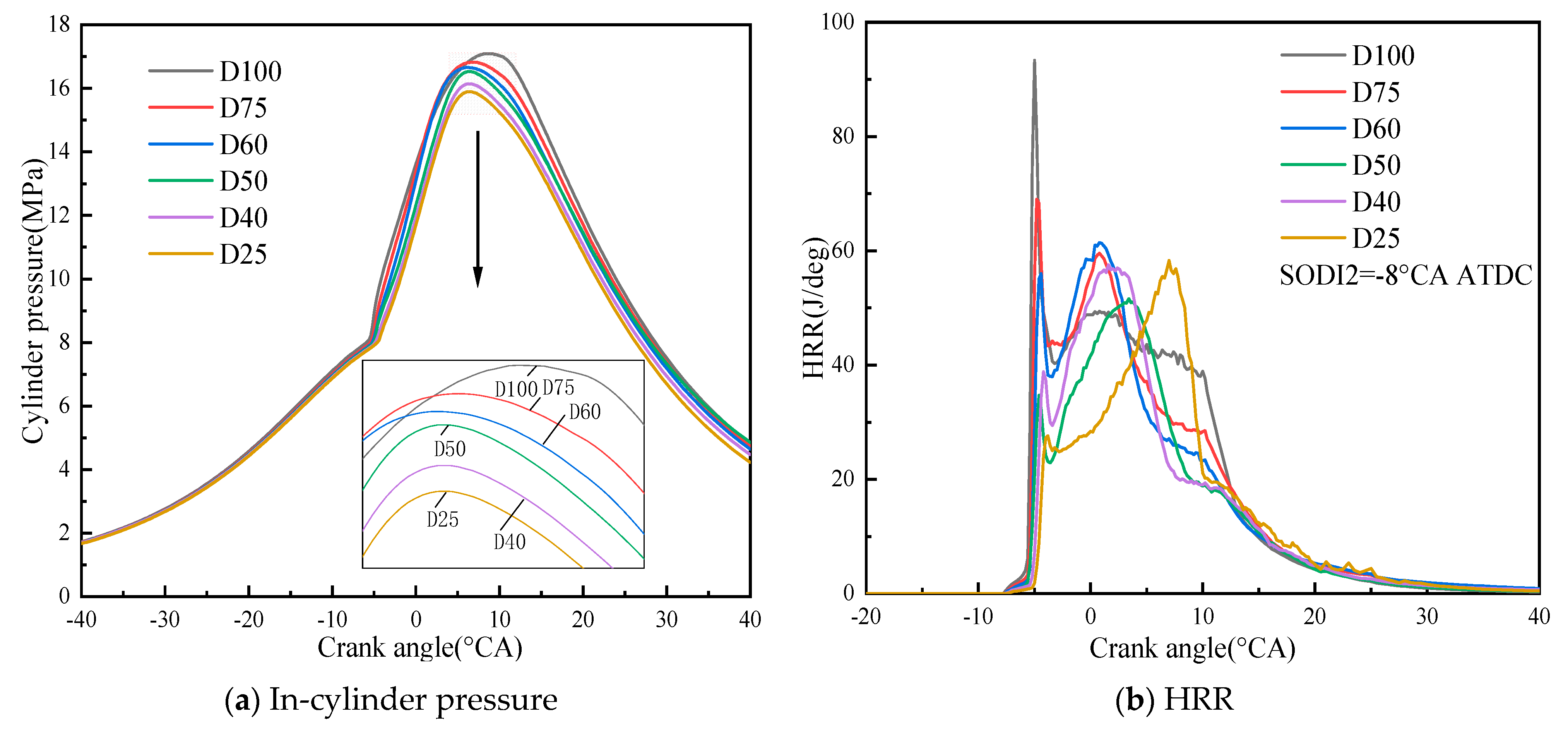
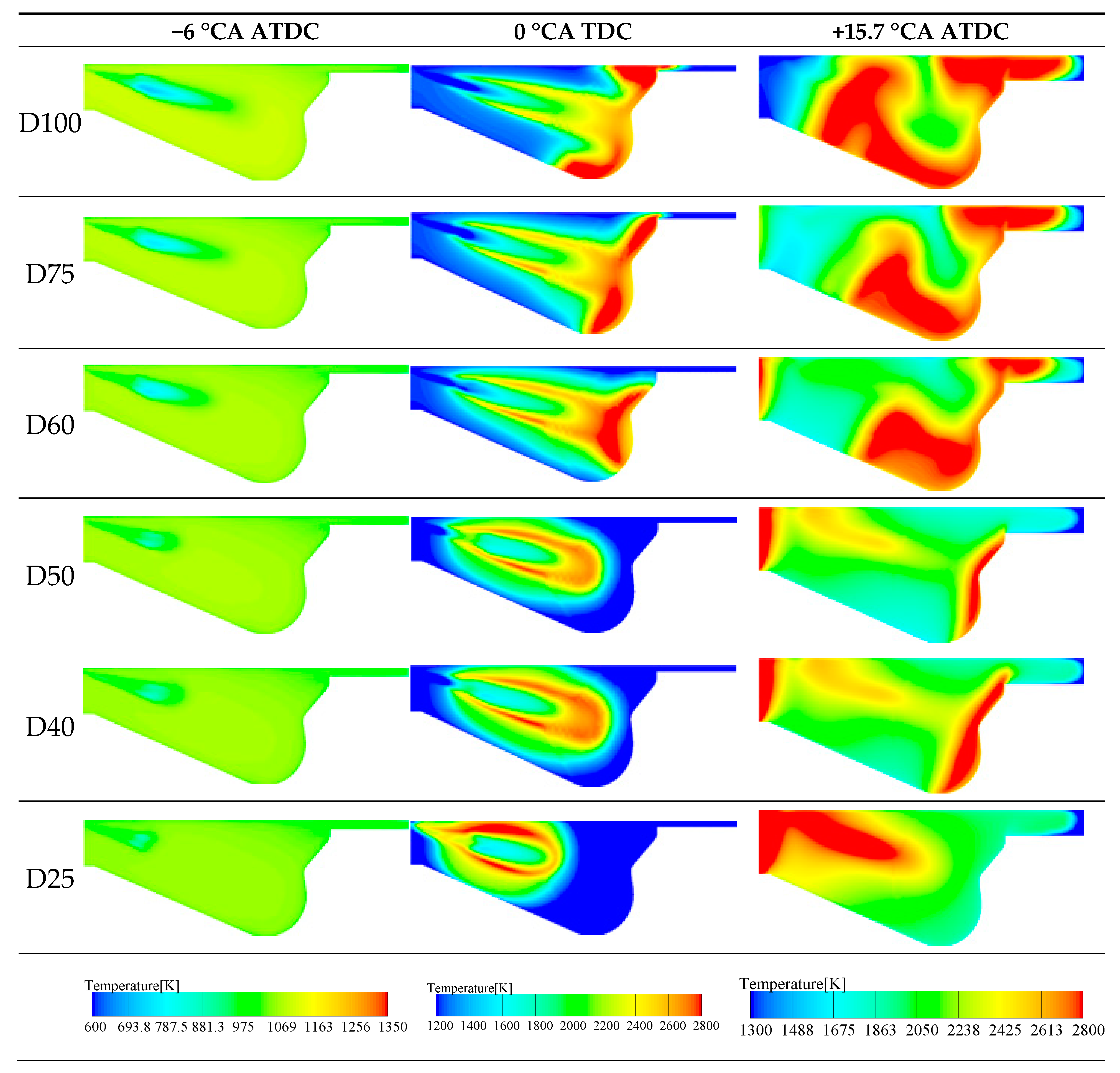

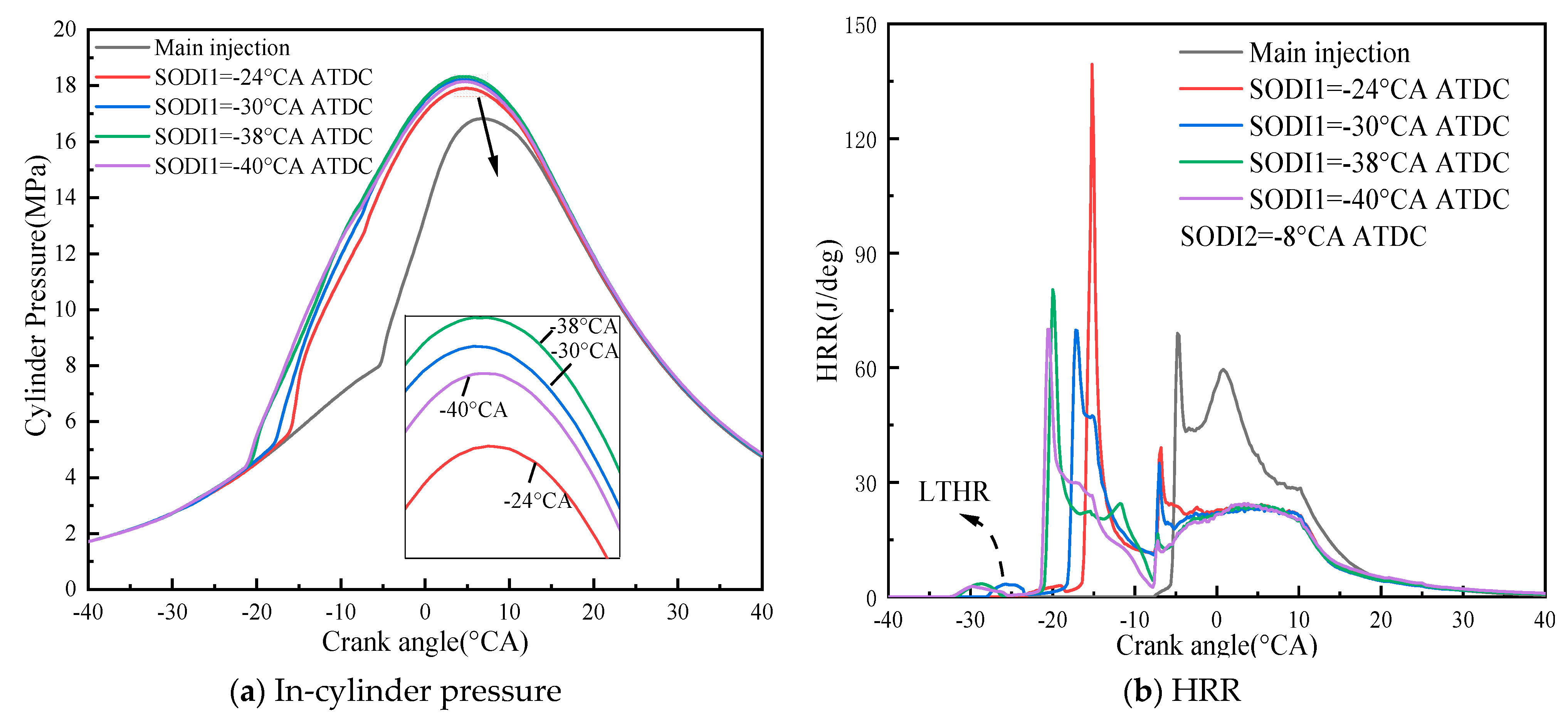

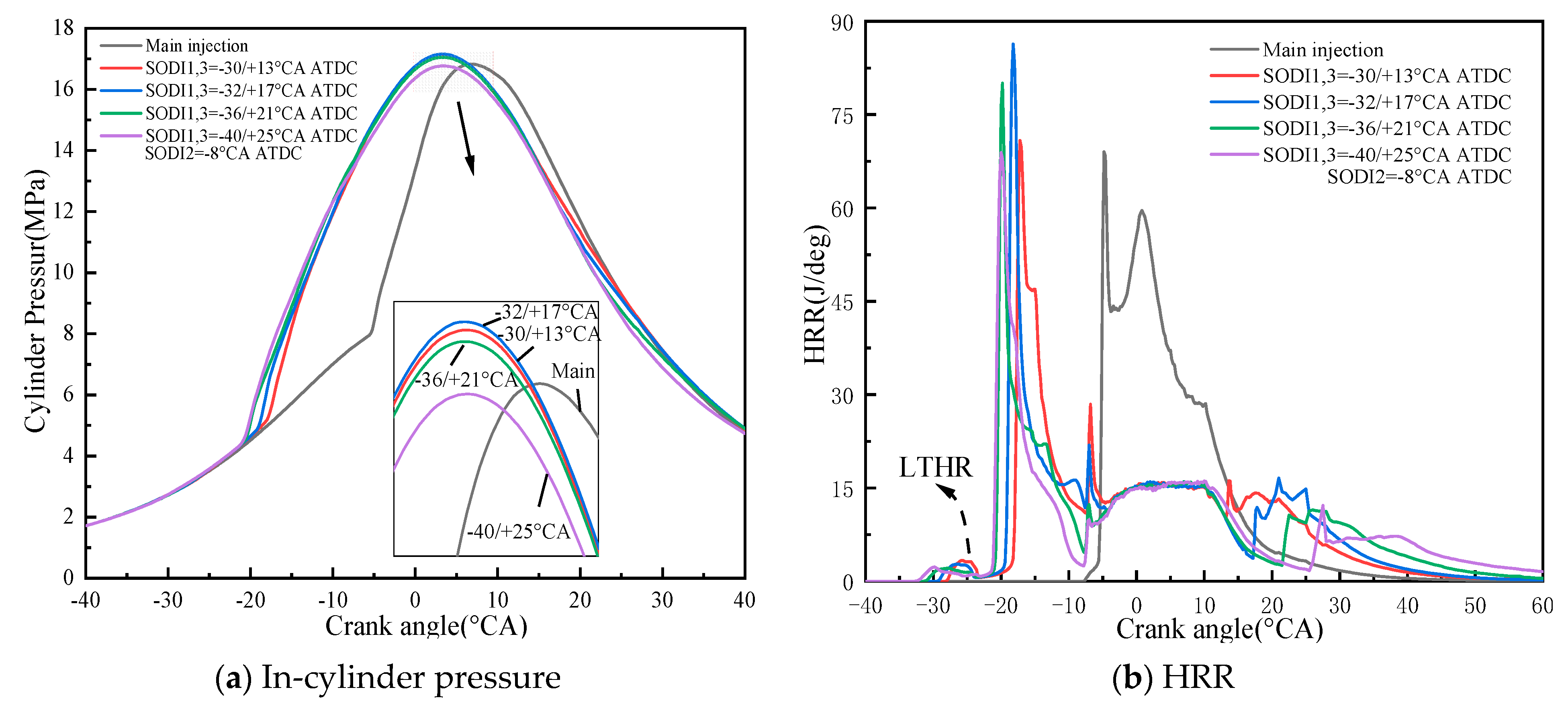
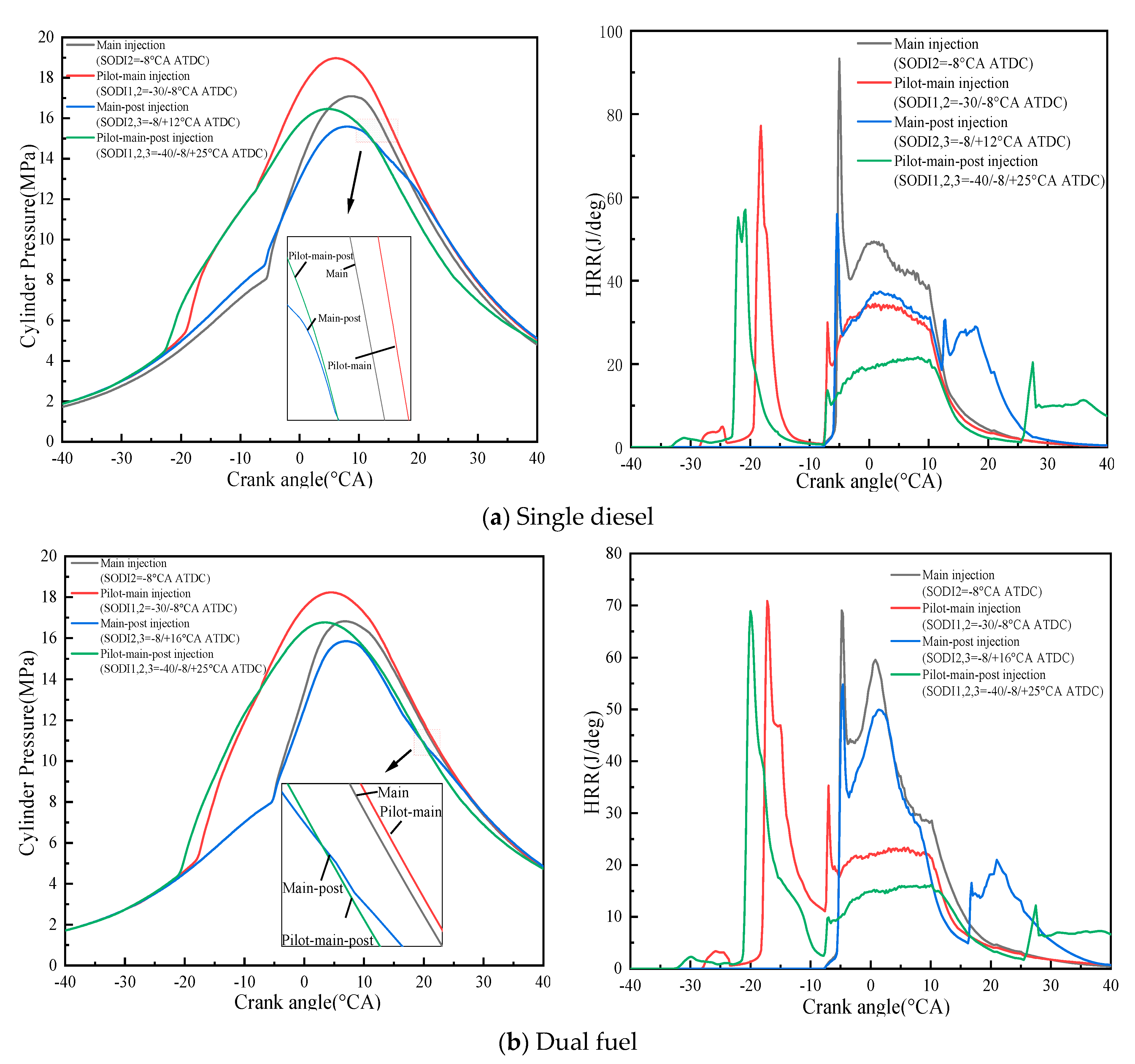

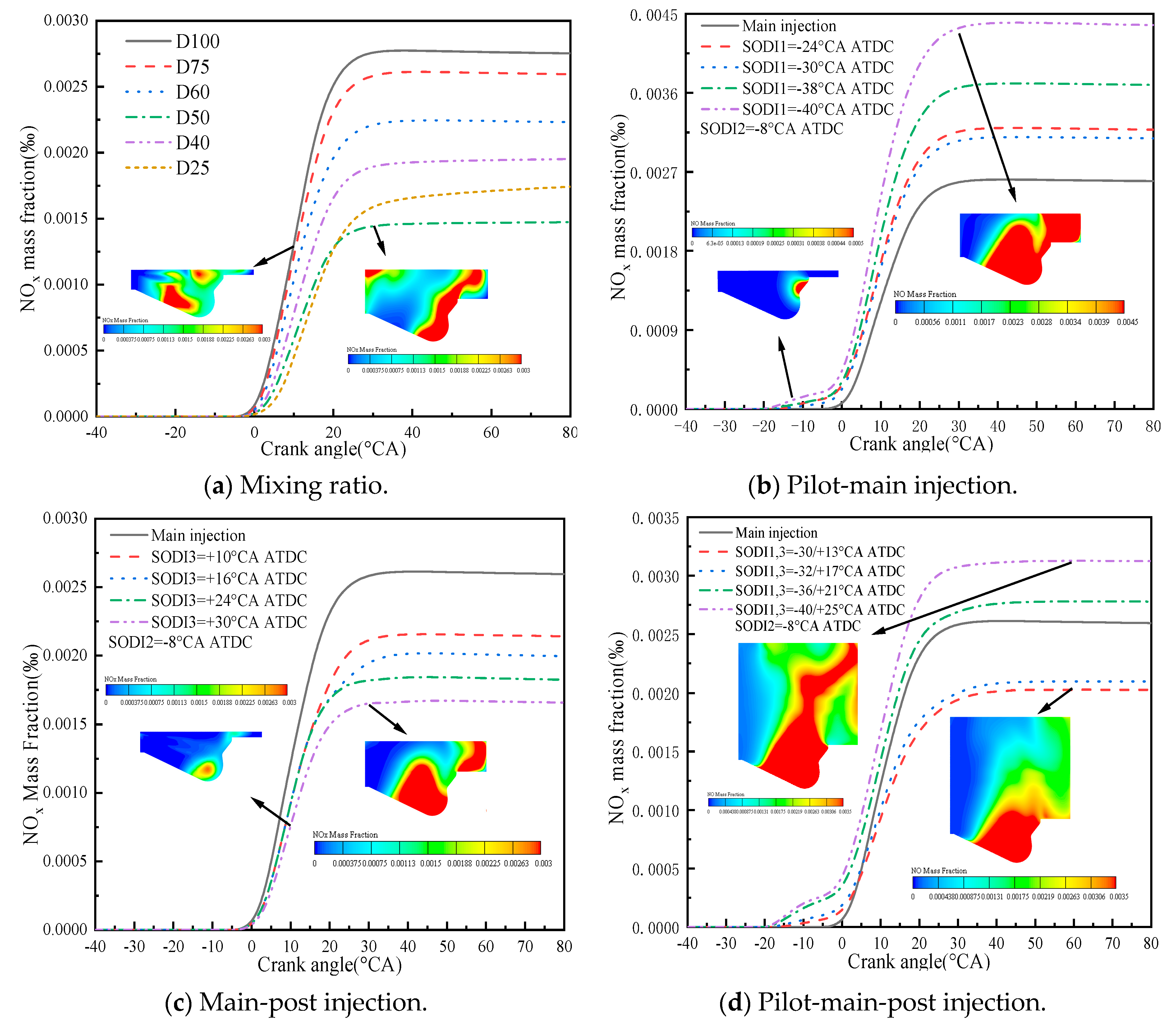
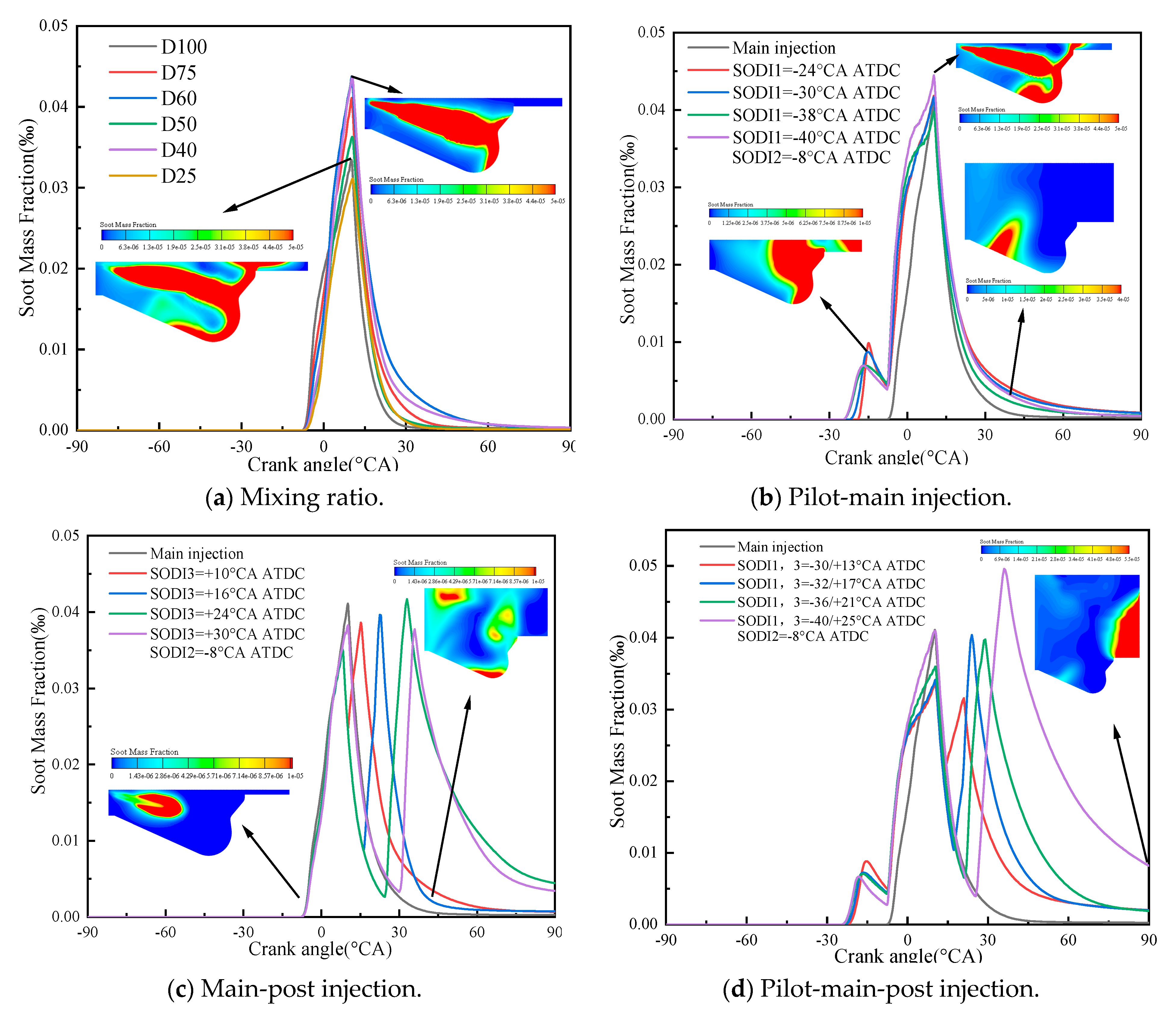
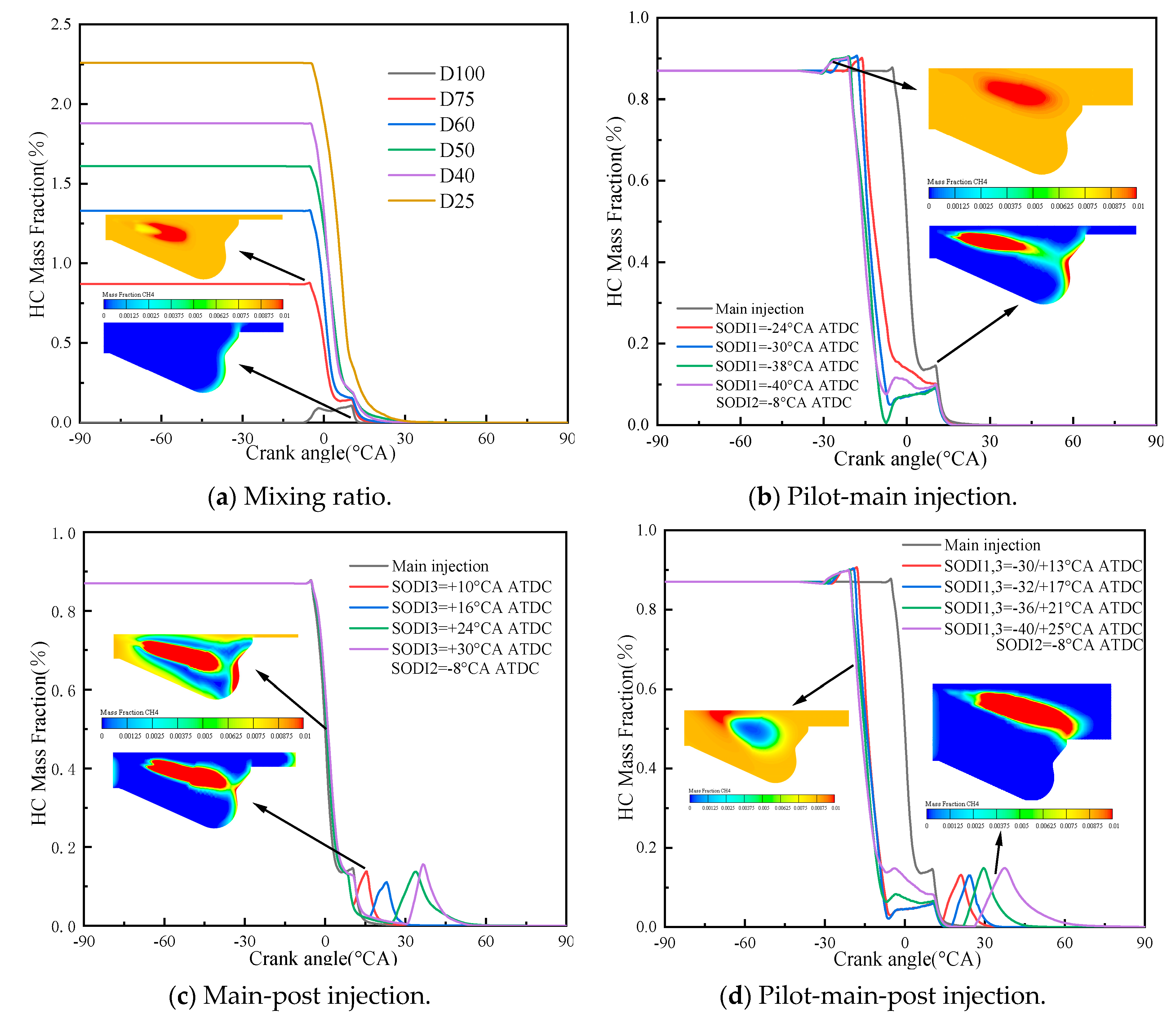


| Parameter | Unit | Value |
|---|---|---|
| Number of cylinders | - | 6 |
| Compression ratio | - | 17 |
| Bore × Stroke | mm | 126 × 155 |
| Displacement | L | 11.5 |
| Connecting rod | mm | 235 |
| Cooling system | - | water-cooling |
| Fuel injection | - | Common rail system |
| Inlet valve closing | deg | 564 |
| Exhaust valve opening | deg | 848 |
| Number of holes | - | 8 |
| Hole diameter | µm | 0.121 |
| Included spray angle | deg | 145 |
| Injection pressure | MPa | 150 |
| Related Parameters | Natural Gas | Diesel |
|---|---|---|
| Ignition temperature (°C) | 650 | 260 |
| Octane number RON | 130 | 20–30 |
| Theoretical air fuel ratio | 17.25 | 14.6 |
| Low calorific value (MJ·kg−1) | 50.05 | 44.4 |
| High calorific value (MJ·kg−1) | 55.54 | 47.1 |
| Calorific value of mixture (kJ/m3) | 3230 | 3790 |
| Boiling point (°C) | −161 | 280 |
| Density (kg/m3) | 0.716 | 814 |
| CH4 (%) | 97.6 | - |
Publisher’s Note: MDPI stays neutral with regard to jurisdictional claims in published maps and institutional affiliations. |
© 2021 by the authors. Licensee MDPI, Basel, Switzerland. This article is an open access article distributed under the terms and conditions of the Creative Commons Attribution (CC BY) license (https://creativecommons.org/licenses/by/4.0/).
Share and Cite
Luo, J.; Liu, Z.; Wang, J.; Chen, H.; Zhang, Z.; Qin, B.; Cui, S. Effects of Different Injection Strategies on Combustion and Emission Characteristics of Diesel Engine Fueled with Dual Fuel. Processes 2021, 9, 1300. https://doi.org/10.3390/pr9081300
Luo J, Liu Z, Wang J, Chen H, Zhang Z, Qin B, Cui S. Effects of Different Injection Strategies on Combustion and Emission Characteristics of Diesel Engine Fueled with Dual Fuel. Processes. 2021; 9(8):1300. https://doi.org/10.3390/pr9081300
Chicago/Turabian StyleLuo, Jianbin, Zhonghang Liu, Jie Wang, Heyang Chen, Zhiqing Zhang, Boying Qin, and Shuwan Cui. 2021. "Effects of Different Injection Strategies on Combustion and Emission Characteristics of Diesel Engine Fueled with Dual Fuel" Processes 9, no. 8: 1300. https://doi.org/10.3390/pr9081300
APA StyleLuo, J., Liu, Z., Wang, J., Chen, H., Zhang, Z., Qin, B., & Cui, S. (2021). Effects of Different Injection Strategies on Combustion and Emission Characteristics of Diesel Engine Fueled with Dual Fuel. Processes, 9(8), 1300. https://doi.org/10.3390/pr9081300






